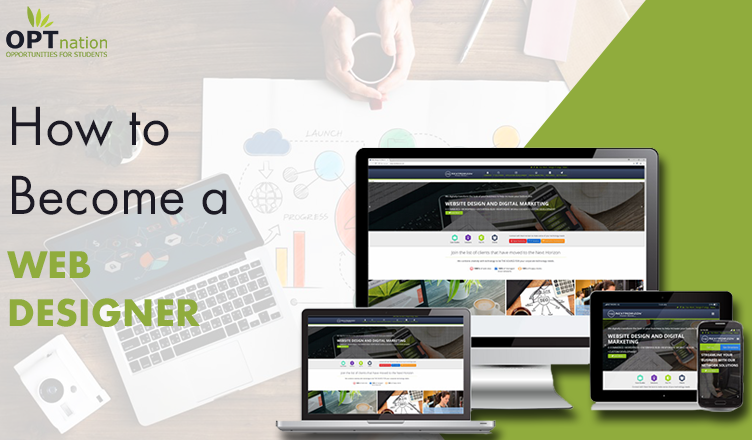Become a Web Designer:
A web designer is an integral part of every web design team. They are responsible for the process of creating a website, including making beautiful designs and analyzing user behavior. This profession is one of the most popular today since every company and individual professional needs a website to be visible online. So how can you become a web designer? Read this post to find out.
What is Web Design?
It is a common belief that, much like an artist, a web designer composes a site by adorning it with pictures and decorations, but that is only one of the profession’s tasks. This list of web designers would agree that in reality, their role is to create intuitive and simple to use sites based on observation and analysis of user behavior. It is only after analysing the data, as well as user behaviors, does the designer manifest the blocking, color scheme, and visual accents of a site. The designer’s goal is to put together a site in such a way as to grab the visitor’s attention, deepen their interest, and relay the site’s intended message. There are several web design areas the designer must focus on:
- Using internet marketing and analytics in order to assess how advertising works and to determine the basic understanding of the site’s existence.
- Communicating with team members and customers
- Writing and editing (due to the inherent relationship between text and design)
- Understanding viewer psychology to tailor the design specifically to topics viewers find important.
- Comprehension of front-end development to relate how a particular layout will look to the end-user once the designed site is live.
- Graphic design, illustration, animation, and interactive banner creation.
What Does a Web Designer Do?
Among the web designer’s primary responsibilities are drawing out layouts for landing pages, setting up company websites and online stores, and generating design interfaces for various online services. They may also be responsible for drawing banners and creating templates for email newsletters.
What is a Designer’s Workflow?
The designer’s job is not fully driven by tapping into creativity from inspirations, as concrete workflow steps are required to turn an idea into a workable online solution.
- Sometimes customers know exactly what they want, in which case data is provided to the designer about the idea and needs of clients. But this does not always happen, prompting questions by the designer to get the necessary information. The designer writes the task, sets the requirement, and answers questions in brief.
- The designer then puts together prototypes or sketches of what they envision the site looking like once it is designed, doing so either in special programs or on paper. These prototypes are essentially the blueprint schematics, mapping out where all of the main elements on the site are to be included.
- Site development begins by utilizing such prototypes to evaluate whether all elements are located in the correct place and get the customer’s agreement on the matter. It is best to address all of the questions regarding structure during the prototype phase, as that is far easier to change than the drawn layout.
- Once the prototype is finalized, it is used as the basis for the designer to draw a color model. The designer can then work on the color array of the site, as well as the addition of any necessary images, graphics, animations, text, and videos. Once finished, the designer passes the final layout to either the developer to write the back-end, transforming it to a site, or to the customer directly.
ALSO READ:
High Paying Top IT and Tech Jobs in Demand for Future
Highest Paying Computer Science Jobs and Salary in USA
Learning Web Design
If you want to become a web designer, you should start by obtaining basic skills. First, learn to work with graphic editing software such as Adobe Photoshop, Adobe Express, Adobe Illustrator, and Corel DRAW, reaching at least an intermediate ability level (having the ability to complete tasks with the fastest possible turnaround).
In the meantime, get an understanding of your profession. This includes understanding basic web design concepts, site layout, color pelleting, composition, balancing, modular grid texture, contrast, typography, etc. Grasping these concepts and developing your personal taste is going to help you in your future career.
Finally, find a design agency that accepts beginners and tries to gain an entry-level position there. Another way of obtaining relevant experience is to register on a website for freelancers and practice with projects there. As you complete freelancing orders, you bolster your experience and enhance your reputation. The best type of practice is to be able to work on actual orders on your own and learn by doing and figuring things out along the way. However, the quality of your work might be inferior to that of other designers. So you might want to take some orders for free or work in collaboration with a more experienced designer who can correct your mistakes.
Don’t forget to always study and grow professionally. At first, your skill level will be really low, but with time, you will find regular customers and make a good income. Then you can become, for example, a director of an art studio. This path of self-improvement and growth is endless.
Conclusion
Web design is constantly changing; new directions and technologies appear every year. As such, designers need to constantly keep up with the changing trends and stay current with the most recent technology. Because web designers need to understand multiple facets when creating modern products, their role is more than just that of a designer; but it is also part-analyst and part subtle psychologist.

